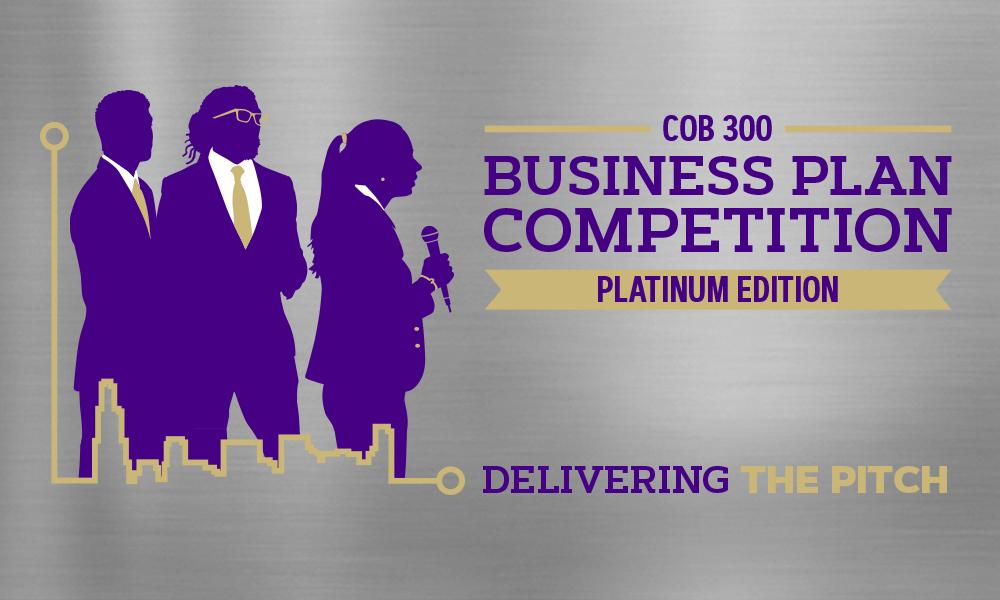Twenty years later, Business Plan Competition still putting students through their paces
News
SUMMARY: Gateway curriculum prepares students to take the stage.
By David Doremus
Long before “Shark Tank” memes had become pop-culture fodder, JMU College of Business faculty members were having students role-play on some of the same business fundamentals that have become the reality-TV show’s signature tropes, including market niche, accuracy of valuation, capital structure and presentation polish-and-sophistication.
These early forays in engaged learning had evolved, by 1998, into COB 300−a core curriculum anchored by a centerpiece project that requires each team of students to develop its own blueprint for building a business from the ground up.
The student-teams formulate their business plans while also learning and integrating basic principles of finance, management, marketing and operations through completion of 12 credit-hours of weekly classroom work. Often described as the “gateway” to the College of Business, COB 300 is usually taken during the junior year, after a student’s formal acceptance into the program.
“They must hit the ground running,” says Fernando Pargas, a lecturer in management and the coordinator of COB 300. “It’s ‘Congratulations, you've been accepted into the College of Business,’ and next comes possibly the most intimidating course you'll ever take.”
“Students learn that it's not about just one isolated discipline, it's about being creative and innovative in helping the organization move to the next level,” says Michael Busing, dean of the College of Business. “The culminating experience is the business plan–and the possibility that it may merit consideration for the annual business plan competition.”
The competition, now in its 20th year, was created by Don Rainey (ʼ82), who remains one of the principal figures involved in organizing its annual renewal. It is set for March 25, at 3 p.m. in Hartman Hall, within the College of Business Learning Complex.
With more than $25,000 in scholarships on the line, the competition does in some ways resemble “Shark Tank” and its imitators, on which entrepreneurs pitch ideas to potential investors in hopes of finding one with pockets deep enough to give life to their fledgling projects.
|
"The students get to interact with successful, high-profile, engaged adults. The presence of the judges validates them as future peers." -Don Rainey ('82), founder of Business Plan Competition, judge |
For the 2022 “platinum edition” of the competition, which was first staged in 2003, COB 300 faculty members selected a dozen plans from the more than 100 created during the preceding year’s spring, summer and fall semesters. Those 12 were reviewed and evaluated, and then pared to just five deemed worthy of a berth in the finals.
Sarah Knecht (ʼ19), co-MVP of Safe & Sound, the 2019 winner, says there was a perceptible shift in her team’s perspective after they received the email telling them they had been selected as finalists. “We began to realize,” she says, “that maybe this wasn't just for a grade in a class—that it might be part of something bigger.”
“For us, the opportunity to win a scholarship was really important,” says Brett Danielson (ʼ19), MVP of 2018’s winning team. “All of us had student debt, so it was a big deal for us to compete where there would be real rewards if we did something good.”
The competition’s enduring worth also derives in great measure from the coaching and wise counsel teams receive from the competition judges. Foremost among them is Rainey, the event’s founder and most passionate advocate.
“The business plan competition is usually the first chance students get to demonstrate their skills with real value at stake,” Rainey says. “Classroom lectures and seminar work and discussions are important, but the competition takes those things further by testing the real-world application of what they’ve learned”−with meaningful monetary benefits hanging in the balance.
During the competition’s two decades of existence, more than 100 teams, representing nearly 650 individual team-members, have taken part. More than 90 judges have dedicated their time and business acumen to helping form the entrepreneurs and executives of the future.
“The students get to interact with successful, high-profile, engaged adults,” Rainey says. “The presence of the judges validates them as future peers.”
The quality and execution of the presentation and the ensuing question-and-answer session weigh heavily among the criteria on which the business plans are judged, as do the originality of a team’s idea and its potential to be profitable. Teams are also grilled on details of their plans as they relate to the four fundamental disciplines–finance, management, marketing and operations.
Danielson, for whom the opportunity to win a scholarship was among the competition’s chief attractions, is now CEO of BarTrack Technologies, LLC, the company that evolved from his team's winning idea. BarTrack is the developer and marketer of a technology solution that helps bars, breweries and restaurants manage their inventory and, ultimately, eliminate waste.
"The problem we analyzed in the business-plan competition was what we ended up creating an actual product for," says Danielson.
"I can definitively state that my life would be completely different" were it not for the competition, he says. Danielson counts more than 20 present or former JMU students who have joined him in the launch of BarTrack–either as employees, investors or advisors.
“We've made the entrepreneurial journey,” he says, “from running the business out of our living room, to now, where we have offices and a manufacturing plant.” Danielson notes with pride that the company not only survived the darkest days of the COVID-19 pandemic, it “grew substantially” in the process.
He will return to campus this year to take his place on the panel of judges for the 2022 competition.
For Rainey, the competition’s greatest reward is witnessing the process by which student-participants like Danielson come into their own as business professionals.
“The personal growth is moving to see,” he says. “Students take the stage with all their fears and anxieties and self-doubts on display. The transformation that occurs within just a few hours is something to behold.”
